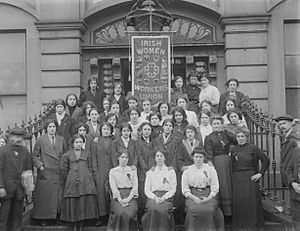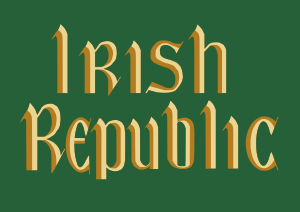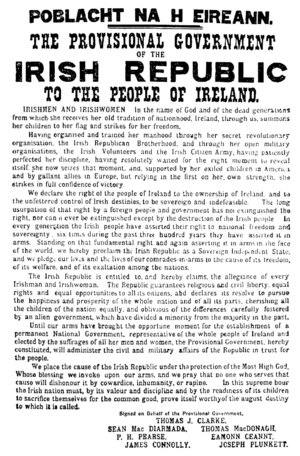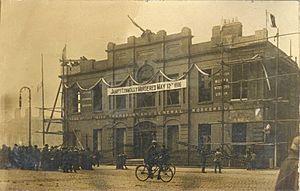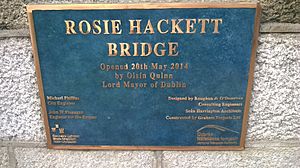Rosie Hackett facts for kids
Quick facts for kids
Rosie Hackett
|
|
|---|---|
| Born |
Rosanna Hackett
25 July 1893 Dublin, Ireland
|
| Died | 4 May 1976 (aged 83) Dublin, Ireland
|
| Nationality | Irish |
| Occupation | Messenger, printer, cooperative organiser |
Rosanna "Rosie" Hackett (born 1893, died 1976) was an important Irish woman. She was a brave fighter for workers' rights and a leader in trade unions. She helped start the Irish Women Workers' Union. She also supported workers during the big 1913 Dublin Lockout strike.
Later, she joined the Irish Citizen Army. She played a part in the 1916 Easter Rising, a major event in Irish history. In the 1970s, she received a gold medal for her many years of hard work. In 2014, a Dublin city bridge was named after her to remember her contributions.
Contents
Rosie's Early Life and Activism
Rosie Hackett was born in Dublin in 1893. Her family was working-class. Her father, John Hackett, was a hairdresser. Her mother was Roseanna Dunne. In 1901, she lived with her widowed mother and five family members. They lived in a tenement building in the city centre. Her father likely died when she was very young.
In 1909, Rosie joined the Irish Transport and General Workers' Union (ITGWU). This union was started by Jim Larkin. This was the start of her long life in trade unionism. By 1911, she lived with her family in a cottage. Her mother had remarried Patrick Gray. In the same year, Rosie helped start the Irish Women Workers' Union (IWWU) with Delia Larkin. Rosie never married. She lived in Fairview with her brother Tommy until she died in 1976.
Fighting for Workers' Rights
Rosie Hackett spent many years fighting for workers' rights. She worked with the Irish Transport and General Workers Union (ITGWU). She also worked with the Irish Women Workers' Union (IWWU) and the Irish Citizen Army. Through her efforts, she helped create better working conditions for people today.
Rosie started her career packing goods in a paper store. Then, she became a messenger for Jacob's biscuits. At that time, the working conditions in the factory were very poor.
Supporting Workers in the 1913 Lockout
On August 22, 1911, Rosie helped organize women workers at Jacob's factory. They stopped working to support their male co-workers who were on strike. With the women's help, the men won better working conditions and a pay raise.
Two weeks later, at age eighteen, Rosie helped start the Irish Women Workers' Union (IWWU). She founded it with Delia Larkin. During the 1913 Lockout, Rosie helped Jacob's workers join the strike. They stood with other workers who were locked out by their employers. Rosie continued to help others. She and her IWWU friends set up soup kitchens at Liberty Hall. They fed the striking workers. However, in 1914, Jacob's fired her because of her role in the Lockout.
Rosie's Role in the 1916 Easter Rising
After being fired, Hackett started working as a clerk. She worked in the print shop at Liberty Hall. This is where she became involved with the Irish Citizen Army. Rosie helped prepare for the 1916 Rising. She worked in a union shop. She helped printers and made first-aid kits and backpacks.
If other union members needed to find James Connolly, she would help them. Rosie "worked as a canvasser and traveler." She was asked to do "many confidential jobs." She took first aid training for six months before the Rising. Dr. Kathleen Lynn taught the classes. Rosie also attended night marches organized by the Irish Citizen Army.
Rosie said, "A week before Easter, I took part in the ceremony of hoisting the challenge flag over Hall." Like other women in the Rising, she carried messages and guns. She also prepared uniforms and food for Irish Republican Army members. This was "sometimes risky work."
Three weeks before the Easter Rising, the Royal Irish Constabulary raided a shop where Rosie worked. She was alone when they came. They were looking for a copy of "Gael." She told them to "wait till I get the head." She called for Connolly. The police were stopped by Connolly and Helena Molony, who were armed. Rosie quickly hid everything. So, when the police came back, they found nothing. Because of this event, the police knew they were armed. Rosie had to work at Liberty Hall all the time.
Printing the 1916 Proclamation
Rosie Hackett was part of the group that printed the first proclamation. She used her experience from the print shop. She helped print the Proclamation of the Irish Republic. She was in the printing room at Liberty Hall in 1916. She was a trusted messenger. This was the first time she was allowed in.
She knew about their printing problems. "They hadn't much type," she said. "The type was short and they had to patch it up a bit." They worked at night. She remembered three men were there when she entered the room. One man shook her hand and congratulated her. This made her very proud. Especially because no one else was allowed in. She later told her family that she handed the wet proclamation to James Connolly. Then, Padraic Pearse read it aloud on the steps of the GPO.
Rosie in the Irish Citizen Army
Rosie Hackett was an active member of the Irish Citizen Army. On Easter Tuesday, she took part in the 1916 Rising. She was under the command of Constance Markievicz. Rosie was located near St Stephen's Green and the Royal College of Surgeons. This position was heavily attacked. They were short on first-aid supplies. It "looked like a death trap."
However, after moving from an exposed spot, it was one of the last positions to surrender. At the Royal College, Rosie Hackett was a first-aid worker. She was allowed into the lecture room, which was only for the Red Cross. Another first-aider, Nora O'Daily, later said about Rosie: "I have a very kind remembrance of Little Rosie Hackett of the Citizen Army, always cheerful and always willing; to see her face about the place was a tonic itself."
After surrendering, the rebels were taken to Dublin Castle. Rosie was imprisoned in Kilmainham Jail for ten days.
Defending Liberty Hall in 1917
In 1917, on the anniversary of Connolly's death, Rosie took action. She, along with Helena Molony, Jinny Shanahan, and Brigid Davis, printed a poster. It said, "James Connolly, Murdered May 12th, 1916." They hung it on Liberty Hall.
The police took down the first poster put up by union members. So, the women worked to make sure their poster stayed up longer. They stayed on the roof to protect it. They blocked the door with a ton of coal. They put nails on the windows. The poster stayed up until 6 PM. Thousands of people saw it. Rosie reported that "it took four hundred policemen to take four women." They were not arrested to avoid public embarrassment. She described their feelings about this action: "We enjoyed it at the time – all the trouble they were put to."
A Lifetime of Union Work (1917–1970)
After the Rising, Rosie returned to the IWWU. At its peak, this union had over 70,000 women members. After the 1945 laundry strike, they won an extra week of paid holidays for workers. Rosie attended many important union events. This included the opening of the new Liberty Hall in 1965. She also attended the Arbour Hill memorial services.
She managed the trade union shops until she retired. This means she was active in the Irish trade union movement for over 50 years. She worked to improve conditions for Irish workers. In 1970, she received a gold medal. This was for fifty years of ITGWU membership.
Rosie Hackett's Legacy
In the 1970s, Walter McFarlane, a union leader, gave Rosie an honorary badge. This was for her fifty years of helping the union.
Rosie never married. She lived in Fairview with her brother Tommy until she died in 1976. She was buried in St Paul's plot. This is in Glasnevin cemetery. She was buried next to her mother Roseanna and stepfather Patrick Gray. At her burial, she received a military salute. Her coffin was covered with the Irish flag.
After she passed away, her legacy was remembered. The union's newspaper told the story of Rosie's struggles. It also told of the struggles of Dublin's working class. She fought to change their lives.
In May 2014, the Rosie Hackett Bridge was officially opened. The Lord Mayor of Dublin opened it. The campaign to name the bridge after her began in 2012. Three women led this campaign: Angelina Cox, Jeni Gartland, and Lisa Connell. Rosie Hackett's name was the top choice for the new bridge.
In April 2015, a plaque was put up on Foley Street. It was unveiled by the North Inner City Folklore Project. This plaque remembers the women of the Irish Citizen Army. The plaque lists Rosie Hackett as a member of the St. Stephen's Green/College of Surgeons group during the 1916 Easter Rising.


